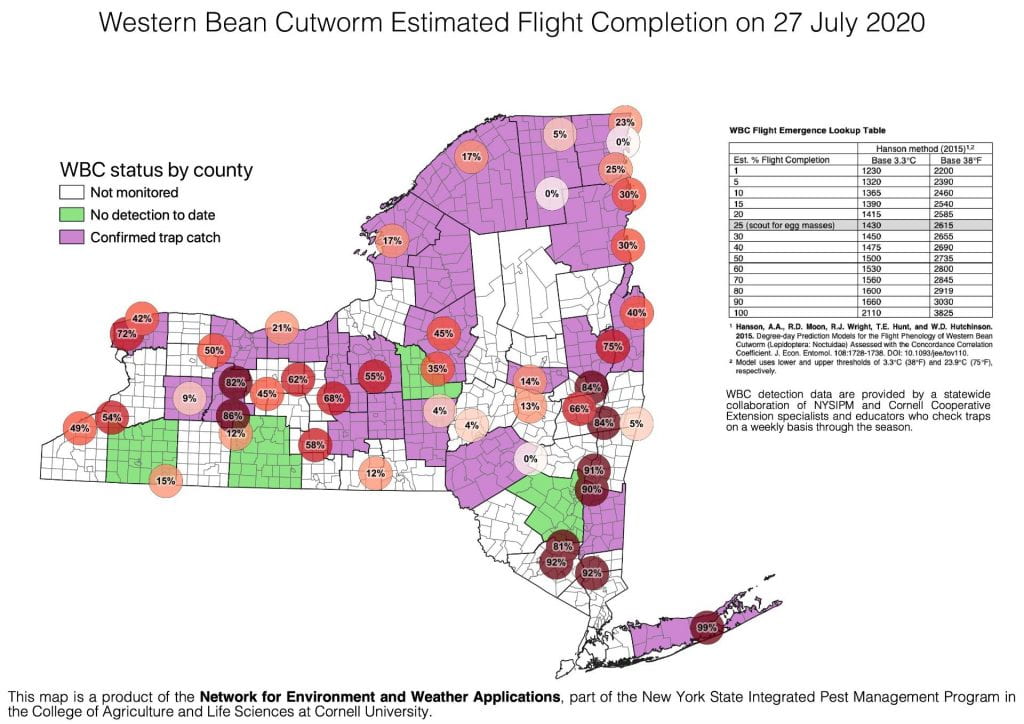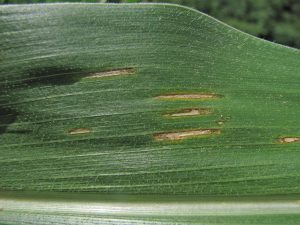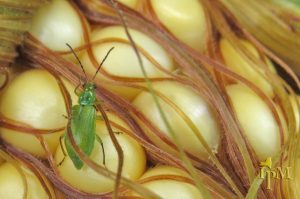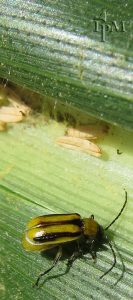Volume 19 Number 12
Contents
View from the Field
Potato leafhopper
Potato Leafhopper (Empoasca fabae) (PLH) populations in alfalfa remain at extremely high levels in some areas of NY. There are many alfalfa fields over threshold across the state with a lot of damage. Make sure to get out and check fields for potato leafhopper. If damaged alfalfa is sprayed, it will green up but the quality will remain low. If you have damage and the alfalfa is short, it is best to clip off the alfalfa. Once the alfalfa is clipped, monitor for PLH and spray an insecticide if the field reaches the economic threshold.
Western Bean Cutworm
The number of Western Bean Cutworm (Striacosta albicosta) moth captures have dramatically increased this week. The number of moths caught in Northern NY has increased this last week. Peak flight of the moths will likely happen in the next two weeks. It is time to get out and scout for eggs laid on the leaves.
Western Bean Cutworm Eggs (Photo by Mike Hunter-CCE)
The following is the prediction of current western bean cutworm flights using degree-days. This map was created by Dan Olmstead (NYS IPM-NEWA).
The following is the number of moths caught by trap location across NY for last week.
Corn Diseases
Gray Leaf Spot and Northern Corn Leaf Blight are starting to show up at low to moderate levels in a few cornfields this last week. These are important diseases to monitor if your corn is susceptible. Management options are available here.
Northern corn leaf blight lesion (photo by J. Cummings, NYS IPM)
Horn Flies
I have noticed very high populations of horn flies on cattle this week. Horn flies are a biting fly and can take 20 blood meals each day. They can cause the cattle pain and annoyance. If your cattle have many flies, you might consider using a back-rubber insecticide type product. The threshold for control is 100 horn flies for dairy cattle and 200 for beef cattle.
500-plus horn flies on one side of the cow.
Soybean Insect Pests
Spider mites and Japanese beetles persist at low to moderate levels on soybeans across the state.
Spider mite damage on soybean (photo by M. Stanyard, CCE)
Japanese beetles and damage on soybean (photo by J. Cummings, NYS IPM)
Corn Rootworm Scouting
Jeff Miller (Field Crops Extension Educator-Oneida County)
Corn rootworm (CRW): Corn has new silks in many local corn fields now attracting corn rootworms. This is an annual opportunity for local growers to save money on future seed purchases. Taking a half hour to scout a field and scouting the field once a week for 3 consecutive weeks for corn rootworm thresholds can indicate if you have a need for CRW control. The scouting procedure is as follows: step into the field 50’, grab the silk of the corn plant, start counting CRW on the plant from top to bottom counting western corn rootworms as 1 and northern corn rootworms as 0.5 western equivalents (see pictures below). Go to a plant 10 ft away and continue your count, go to a third plant and continue your count. Repeat this procedure in the middle of the field and then at the far end of the field. Compare your total count with the chart below. So if you counted beetles on 9 plants and found only one western corn rootworm then you were under threshold. If you counted 17 or more you are over threshold. If you were somewhere in between you have to continue your counting until you are either over or under threshold for the number of plants in your sample. If you are over threshold, you have the option to rotate to another crop, if this was your first year of corn next year you could use a seed treatment like poncho 1250 or you could plant a GMO with Bt for corn rootworm.
Corn Rootworm Sequential Sampling Card for Corn Rootworm
Degree Days Base 50 from March 1, 2020
| Station Location |
(Base 50) March 1 |
| Canton | 1395 |
| Ceres | 1281 |
| Chazy | 1337 |
| Geneva | 1528 |
| Highland | 1672 |
| Ithaca | 1439 |
| Kinderhook | 1642 |
| Malone | 1287 |
| Massena | 1368 |
| Oriskany Falls | 1439 |
| Red Hook | 1648 |
| Versailles | 1444 |
| Watertown | 1390 |
Clipboard Checklist
Keith Waldron, NYS IPM
General
*Walk fields to check general field condition, weed issues
*Watch for crop maturity, stand assessments, weed escapes, nutrient deficiencies, lodging issues
Alfalfa:
*Evaluate established legume stands for approximate days until harvest
*Monitor potato leafhopper, foliar, systemic and crown rot diseases.
*Monitor new seedings for potato leafhopper, pythium blight, phytopthora root rot.
Small Grains:
*Monitor spring small grains for signs of Fusarium Head Blight, foliar diseases
*Monitor grain fields for growth stage, disease and lodging issues, grain maturity, harvest timing
*Record diseases present, location and types of weed escapes
Corn:
*Monitor for mid-season corn pests including European corn borer, corn rootworm, western bean cutworm, slugs, foliar diseases such as northern corn leaf blight and gray leaf spot, weed issues, nutrient deficiencies, vertebrate damage.
Soybeans:
*Monitor for crop growth stage, soybean aphid, defoliators, foliar diseases, white mold, weed issues, vertebrate damage
Pastures:
*Check water sources, mend fences as needed.
*Check crop growth, clip pastures between grazing as needed
*Monitor for invasive species, plants harmful to livestock
*Review/Plan rotations
Storage:
* Check stored grain bins for temperature, moisture and signs of mold and insects. Aerate, core, transfer grain or treat as necessary
* Clean and disinfect empty storage bins in preparation for grain harvest
*Check forage allocation and anticipate feed program adjustments as forages from previous year are used up
*Mow around storage bins and facility to minimize pest hiding places
Dairy Cattle Barn Fly Management:
*Monitor animals and barn area for house fly, stable fly and other pest management needs including presence of rodents and birds.
*Check facilities for favorable fly breeding conditions: (organic matter + moisture): leaks in watering systems, roof gutters for leaks and potential overspill, drainage,
*Sanitation, sanitation, sanitation – clean animal resting areas, feed troughs, minimize source of moist organic matter i.e. fly breeding areas in barn and in adjacent animal loafing yard
* Continue fly monitoring: install “3X5″ index card fly speck monitoring cards throughout barn
*Use, replenish, replace fly management materials: sticky fly tapes/ribbons, insecticide baits, natural enemies (parasitoids), fly population monitoring (3 x 5) spot cards
*Consider purchase and release of Muscidifurax raptor and/or M. raptorellus natural enemies of house and stable fly pupae.
Dairy Cattle on Pasture:
*Monitor animals for presence of face flies, horn flies and stable flies. Action guidelines: face flies (average 10 per animal face), horn flies (average 50 / dairy per animal side, 200 / beef cattle per animal side), stable flies average 10 per animal (all four legs)
*Check feed bunk / water source locations for signs of stable fly breeding (moist undisturbed organic matter – spilled feed, round bales, etc.), minimize source of moist organic matter i.e. fly breeding areas in barn and in adjacent animal exercise yard.
*Check pasture for forage quality / quantity, rotate as appropriate
*Check pasture for vegetation poisonous to livestock
*Consider use of pasture fly traps to help reduce deer, horse and stable fly populations












